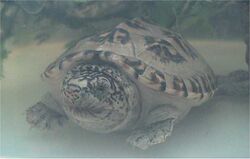Biology:Mexican musk turtle
| Mexican musk turtle | |
|---|---|

| |
| Staurotypus triporcatus | |
| Scientific classification | |
| Domain: | Eukaryota |
| Kingdom: | Animalia |
| Phylum: | Chordata |
| Class: | Reptilia |
| Order: | Testudines |
| Suborder: | Cryptodira |
| Family: | Kinosternidae |
| Genus: | Staurotypus |
| Species: | S. triporcatus
|
| Binomial name | |
| Staurotypus triporcatus (Wiegmann, 1828)
| |
| Synonyms[2] | |
| |
The Mexican musk turtle (Staurotypus triporcatus), also known commonly as the giant musk turtle, is a species of turtle in the family Kinosternidae. The species occurs in Central America and Mexico.
Geographic range
S. triporcatus is found in Belize, northeastern Guatemala, western Honduras, and Mexico. In Mexico it is found in the Mexican states of Campeche, Chiapas, Oaxaca, Quintana Roo, Tabasco, Tamaulipas, and Veracruz.[3]
Description
S. triporcatus is typically much larger than other species of Kinosternidae, attaining a straight carapace length of up to 36 cm (14 in), with males being significantly smaller than females. It is typically brown, black, or green in color, with a yellow underside. The carapace is distinguished by three distinct ridges, or keels, which run the length.[citation needed]
S. triporcatus exhibits XX/XY sex determination, in contrast to the temperature-dependent sex determination of most turtles.[4]
Diet
Like other musk turtle species, S. triporcatus is carnivorous, eating various types of aquatic invertebrates, as well as fish and carrion.[citation needed].
References
- ↑ "Appendices | CITES". https://cites.org/eng/app/appendices.php.
- ↑ Fritz, Uwe; Havaš, Peter (2007). "Checklist of Chelonians of the World". Vertebrate Zoology 57 (2): 261–262. ISSN 1864-5755. Archived from the original on 1 May 2011. https://web.archive.org/web/20110501060224/http://www.cnah.org/pdf_files/851.pdf. Retrieved 29 May 2012.
- ↑ "Staurotypus triporcatus ". The Reptile Database. www.reptile-database.org.
- ↑ Badenhorst, Daleen; Stanyon, Roscoe; Engstrom, Tag; Valenzuela, Nicole (2013-04-01). "A ZZ/ZW microchromosome system in the spiny softshell turtle, Apalone spinifera, reveals an intriguing sex chromosome conservation in Trionychidae" (in en). Chromosome Research 21 (2): 137–147. doi:10.1007/s10577-013-9343-2. ISSN 1573-6849. https://doi.org/10.1007/s10577-013-9343-2.
External links
- Tortoise & Freshwater Turtle Specialist Group (1996). Staurotypus triporcatus. 2006 IUCN Red List of Threatened Species. Downloaded on 29 July 2007.
Further reading
- Wiegmann AF (1828). "Beyträge zur Amphibienkunde ". Isis von Oken 21: 364–383. (Terrapene triiporcata, new species, pp. 364–365). (in German and Latin).
Wikidata ☰ Q1187567 entry
 |


